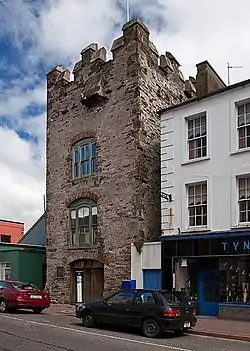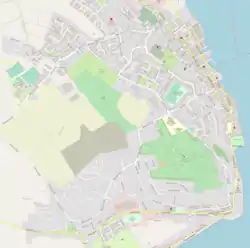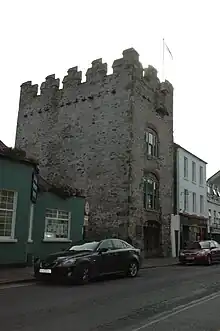Tynte's Castle
Tynte's Castle (/ˈtɪnts/; Irish: Caisleán Tynte)[1] is a tower house located in Youghal, eastern County Cork, Ireland.[2][3][4]
| Tynte's Castle | |
|---|---|
| 148 North Main Street, Youghal, County Cork, Ireland | |
 View of the west face, from the street | |
 Tynte's Castle  Tynte's Castle | |
| Coordinates | 51°57′21″N 7°51′01″W |
| Type | tower house |
| Height | 50 ft (15 m) |
| Site history | |
| Built | late 15th century |
| Built by | Walsh family |
Location
Tynte's Castle is located in the north of Youghal's historic core, on Main Street (anciently King's Street);[5] it is 420 m (460 yd) north-northwest of Youghal's Clock Gate and 220 m (240 yd) east-northeast of St Mary's Collegiate Church. The tower was originally on the riverfront, but when the Blackwater River silted up and changed course in the 17th–18th centuries, it was left 220 m (240 yd) from the water.[6]
History
Tynte's Castle was built in the late 15th century by the Walsh family, Cambro-Norman merchants who built stores and fortified houses in the town to protect their trade goods. After the Second Desmond Rebellion (1579–1583) they were stripped of their property, which reverted to the Crown.
The tower was leased to Sir Robert Tynte (1571–1663) in the late 16th century and refurbished in 1643.[7][8][9]
Oliver Cromwell's army entered Youghal in 1649 during the Cromwellian conquest of Ireland; it is assumed that it was used to quarter Parliamentarian soldiers. In 1689, during the reign of King James II, it was used as a prison for Cromwell supporters and an attempt was made to burn it down.[10] The castle remained with the Tyntes until it was sold in 1866 to William Raymond FitzMaurice, a wealthy Anglo-Irish landowner.
The castle was acquired by the McCarthy family in the 1950s, and they restored it. It is now open to tourists.[10]
Building

A fortified stone tower of three storeys, with base batter.[11] It has a hipped slate roof with machicolations, Irish crenellations and a murder hole.[12] There are large windows in the west wall topped with brick arches; these were probably added in the 19th century when the castle was used as a granary.[8]
References
- "Gaelscoil Choráin | Fúinn".
- Travel, D. K. (3 October 2016). DK Eyewitness Travel Guide Ireland. Dorling Kindersley Limited. ISBN 9780241295243 – via Google Books.
- "Tynts [Tynte's] Castle, Youghal". 1890.
- Groeger, Kieran (8 December 2016). The Little Book of Youghal. History Press. ISBN 9780750981569 – via Google Books.
- Twomey, Michael (3 February 2014). Irish Heart, English Blood: The Making of Youghal. History Press. ISBN 9780750958929 – via Google Books.
- "Tynte's Castle | Youghal, Ireland Attractions". Lonely Planet.
- Lewis, Samuel (14 September 1849). "A Topographical Dictionary of Ireland: Comprising the Several Counties; Cities; Boroughs; Corporate, Market, and Post Towns; Parishes; and Villages; with Historical and Statistical Descriptions: Embellished with Engravings of the Arms of the Cities, Bishoprics, Corporate Towns, and Boroughs; and of the Seals of the Several Municipal Corporations". S. Lewis and Company – via Google Books.
- "Tynte's Castle, Youghal, Cork".
- Society, Cork Historical and Archaeological (14 September 1913). "Journal of the Cork Historical and Archaeological Society". The Society – via Google Books.
- "Irish Castles - Tyntes Castle".
- "Le Tynte's Castle | Guide Ireland.com". www.guide-ireland.com.
- "Tynte's Castle, North Main Street, YOUGHAL-LANDS, Youghal, CORK". Buildings of Ireland.